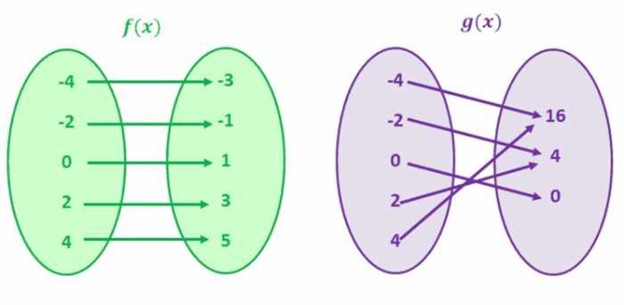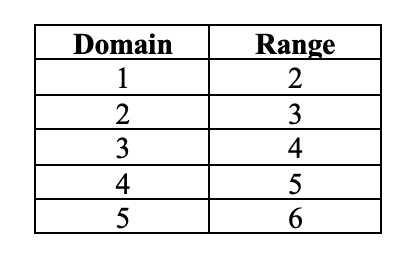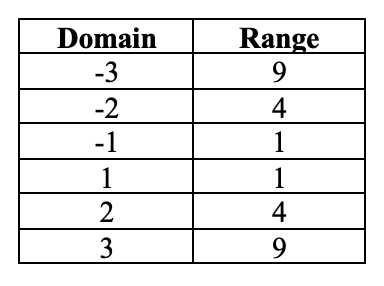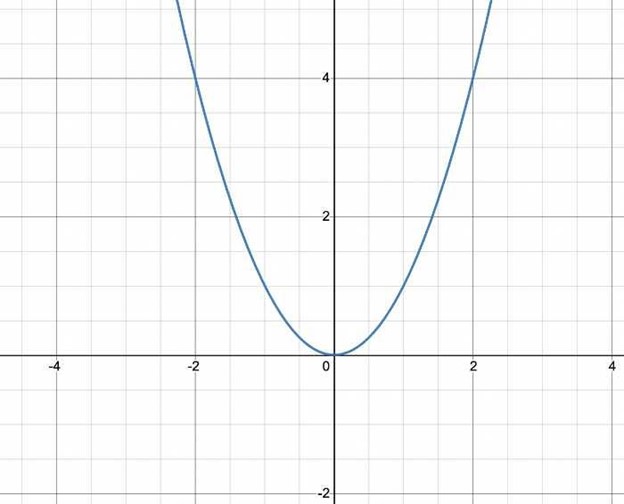One to One Functions - Graph, Examples | Horizontal Line Test
What is a One to One Function?
A one-to-one function is a mathematical function in which each input correlates to just one output. In other words, for every x, there is just one y and vice versa. This means that the graph of a one-to-one function will never intersect.
The input value in a one-to-one function is the domain of the function, and the output value is known as the range of the function.
Let's study the images below:

For f(x), every value in the left circle corresponds to a unique value in the right circle. Similarly, each value on the right side corresponds to a unique value on the left. In mathematical words, this means that every domain owns a unique range, and every range owns a unique domain. Hence, this is a representation of a one-to-one function.
Here are some different representations of one-to-one functions:
-
f(x) = x + 1
-
f(x) = 2x
Now let's examine the second example, which exhibits the values for g(x).
Pay attention to the fact that the inputs in the left circle (domain) do not own unique outputs in the right circle (range). For example, the inputs -2 and 2 have identical output, in other words, 4. Similarly, the inputs -4 and 4 have the same output, i.e., 16. We can discern that there are equivalent Y values for numerous X values. Hence, this is not a one-to-one function.
Here are additional examples of non one-to-one functions:
-
f(x) = x^2
-
f(x)=(x+2)^2
What are the qualities of One to One Functions?
One-to-one functions have the following qualities:
-
The function has an inverse.
-
The graph of the function is a line that does not intersect itself.
-
It passes the horizontal line test.
-
The graph of a function and its inverse are identical with respect to the line y = x.
How to Graph a One to One Function
To graph a one-to-one function, you will need to find the domain and range for the function. Let's examine a straight-forward example of a function f(x) = x + 1.

Immediately after you possess the domain and the range for the function, you need to chart the domain values on the X-axis and range values on the Y-axis.
How can you evaluate whether or not a Function is One to One?
To prove whether a function is one-to-one, we can use the horizontal line test. Once you graph the graph of a function, draw horizontal lines over the graph. If a horizontal line passes through the graph of the function at more than one point, then the function is not one-to-one.
Due to the fact that the graph of every linear function is a straight line, and a horizontal line does not intersect the graph at more than one point, we can also conclude all linear functions are one-to-one functions. Keep in mind that we do not leverage the vertical line test for one-to-one functions.
Let's study the graph for f(x) = x + 1. As soon as you graph the values to x-coordinates and y-coordinates, you have to examine if a horizontal line intersects the graph at more than one point. In this case, the graph does not intersect any horizontal line more than once. This indicates that the function is a one-to-one function.

On the contrary, if the function is not a one-to-one function, it will intersect the same horizontal line multiple times. Let's look at the figure for the f(y) = y^2. Here are the domain and the range values for the function:

Here is the graph for the function:

In this example, the graph crosses multiple horizontal lines. Case in point, for both domains -1 and 1, the range is 1. Similarly, for both -2 and 2, the range is 4. This means that f(x) = x^2 is not a one-to-one function.
What is the opposite of a One-to-One Function?
Considering the fact that a one-to-one function has a single input value for each output value, the inverse of a one-to-one function also happens to be a one-to-one function. The inverse of the function basically undoes the function.
For example, in the case of f(x) = x + 1, we add 1 to each value of x in order to get the output, i.e., y. The inverse of this function will deduct 1 from each value of y.
The inverse of the function is denoted as f−1.
What are the qualities of the inverse of a One to One Function?
The characteristics of an inverse one-to-one function are identical to any other one-to-one functions. This signifies that the reverse of a one-to-one function will have one domain for every range and pass the horizontal line test.
How do you figure out the inverse of a One-to-One Function?
Finding the inverse of a function is simple. You simply have to swap the x and y values. For example, the inverse of the function f(x) = x + 5 is f-1(x) = x - 5.

Just like we reviewed earlier, the inverse of a one-to-one function reverses the function. Because the original output value required adding 5 to each input value, the new output value will require us to deduct 5 from each input value.
One to One Function Practice Examples
Consider these functions:
-
f(x) = x + 1
-
f(x) = 2x
-
f(x) = x2
-
f(x) = 3x - 2
-
f(x) = |x|
-
g(x) = 2x + 1
-
h(x) = x/2 - 1
-
j(x) = √x
-
k(x) = (x + 2)/(x - 2)
-
l(x) = 3√x
-
m(x) = 5 - x
For each of these functions:
1. Identify whether or not the function is one-to-one.
2. Draw the function and its inverse.
3. Figure out the inverse of the function algebraically.
4. Specify the domain and range of both the function and its inverse.
5. Apply the inverse to find the solution for x in each equation.
Grade Potential Can Help You Learn You Functions
If you happen to be facing difficulties trying to learn one-to-one functions or similar concepts, Grade Potential can set you up with a 1:1 teacher who can help. Our Santa Monica math tutors are skilled professionals who support students just like you enhance their understanding of these types of functions.
With Grade Potential, you can learn at your individual pace from the comfort of your own home. Plan a meeting with Grade Potential today by calling (310) 362-2285 to learn more about our tutoring services. One of our team members will get in touch with you to better ask about your requirements to find the best teacher for you!




